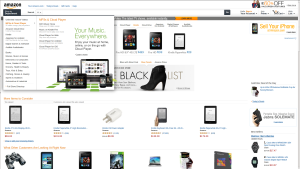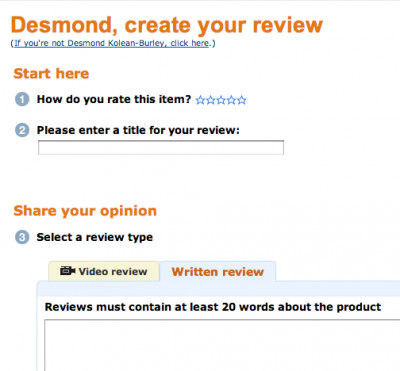Difference between revisions of "Amazon.com"
| Line 7: | Line 7: | ||
|IMAGEURL=http://amazon.com | |IMAGEURL=http://amazon.com | ||
|TEXT=Site | |TEXT=Site | ||
| − | |PLATFORM=Cloud Service<br>Tablet<br>Android App<br>iOs App | + | |PLATFORM=Cloud Service<br>Android Tablet<br>Android App<br>iOs App |
| − | |PRODUCT=Shopping | + | |PRODUCT=Shopping Website<br>Kindle Fire<br>Kindle eReader<br>Kindle Cloud Reader<br>Amazon Cloud Storage |
|TYPE=E-Commerce<br>Hardware Developer<br>Cloud Based Storage<br>Software Developer | |TYPE=E-Commerce<br>Hardware Developer<br>Cloud Based Storage<br>Software Developer | ||
|SITEURL=http://amazon.com | |SITEURL=http://amazon.com | ||
Revision as of 02:33, 20 October 2012
|
Amazon.com, Inc. is one of the largest e-commerce companies worldwide [[1]]. The company is also known for its product line of Amazon Kindle e-book readers, Amazon Kindle Fire tablets, Amazon Web Services cloud computing services, and Amazon Mechanical Turk online marketplace for work. Jeff Bezos founded Amazon.com in 1995 in Seattle, Washington [[2]]. Originally, Amazon.com sold a wide array of books, but it has expanded its inventory to products, including CD's, DVD's, electronics, apparel, and almost any other good from A-Z [[3]].
Contents
History
Jeff Bezos conceptualized Amazon.com in 1994 while working at D.E. Shaw, a global investment management corporation. After weighing the pros and cons through a process he described as "regret minimization" he decided to leave D.E. Shaw in order to pursue his urge to found an online book selling company. Bezos believed e-commerce would become a very profitable business because the Supreme Court had recently decided online sales are not taxable. In addition, he believed online sales would follow a long-tail distribution, allowing Amazon.com to sell and carry books that would not be economical for a physical store to carry. Bezos sold his first book from his garage in 1995. [[4]]
Within the first month of launching the website, Amazon.com had a searchable database of one million books available and had received orders from all 50 states and 45 different countries. Amazon.com stocked roughly 2,000 of the most popular titles and would order the titles they did not stock from wholesalers and publishers. Jeff Bezos eventually moved Amazon.com's fulfillment center from his garage to an office location in Seattle when it was evident Amazon.com was becoming a highly successful operation. Between 1995 and 1997, Bezos added an additional .5 million titles, implemented an approach of discounting nearly all products by 10-30%, and created a review, recommendation, and notification system. In 1997, Amazon.com became a public company in order to raise expansion capital. The company's initial public offering was three million shares. In order to minimize distribution time, Amazon.com opened a new distribution center in New Castle, Delaware. Opening this new location, both minimized the time the books took to reach the customer and the time it took to receive the book from eastern publishing companies. Amazon.com also opened a "Associate" program, allowing other websites who hosted advertisements for books on Amazon.com to receive a commission of 8-15% if a consumer purchased the book after clicking on the ad. In October 1997, Amazon.com was the first website to announce reaching its one millionth customer. In March of 1998, Amazon.com had 2.6 million customers in its database, increasing 1.6 million customers in just five months. Amazon.com continued to expand, entering the music business and purchasing IMDB in 1998. Between 1999 and 2001, Amazon.com's sales continued to climb; however, it continued to post net losses due to Bezos' focus on market share above profit. Many were skeptical of whether Amazon.com would turn a profit after losing over $1 billion over the course of seven years. In 2001, Amazon.com reported its first net profit, and in the second quarter of 2002, it reported its second net profit [[5]].
Website
Reviews
Amazon.com allows consumers to review sellers and products listed on the company's website. Amazon Seller Reviews are a review of a third-party seller's performance in selling the good the consumer purchased. Customers who are intending to purchase a product on Amazon browse through a list of third-party sellers to choose from whom they would like to purchase the product. The review system displays the sellers' aggregate rating along with the total number of people who have reviewed the seller. This can be useful information for a potential buyer of a good and is key in establishing trust between the consumer and the third-party seller.
Amazon Product Reviews allow consumers to review the products they have purchased. First, they are asked to give a 1-5 star overall rating of the product. Second, they require a title for the review. Finally, they ask for a detailed written review or a video review of the product. In addition, to the seller rating, this can be a useful tool to prospective customers of a product.
Third-Party Sellers
Roughly 40% of Amazon's profit is derived from its third-party sellers. Third-party sellers interested in selling on Amazon.com pay roughly an 8% commission to Amazon.com for products they fulfill. Sellers can opt to have their products fulfilled by Amazon.com for a 10-12% commission [[6]][[7]]. Amazon.com reported 1.6 million sellers sold products through Amazon.com in 2009 [[8]]. Unlike eBay payment for these products is handled directly through Amazon.com.
Ethical Controversies
In 2000, an account of price discrimination violating the Robinson-Patman Act was found on Amazon.com. A customer interested in buying a DVD discovered that after deleting his cookies he was offered a lower price for the DVD. In addition to this instance, it was found that customers who had cookies from a bargain-hunter website were offered a substantially lower price ($51 less) on an mp3 player. [[9]]
The Amazon.com review system has been challenged for its accuracy and integrity . In 2004, the New York Times discovered a number of Amazon book reviews were written by the authors themselves either promoting their own book or demoting their competitors' books [[10]].
Products and Services
Amazon Kindle
Amazon Prime
Amazon Prime is a service that provides free two-day shipping on select items to customers who pay an annual amount for an Amazon Prime Membership. Currently, this membership costs $79 for US customers and is offered at $39 for students with a valid university email. In order for an item to be eligible for Amazon Prime, it must be either sold directly by Amazon.com, or a third-party seller must opt to have the item fulfilled by Amazon [[11]]. Third-party sellers interested in having an item fulfilled by amazon (FBA) send their inventory to an Amazon.com fulfillment warehouse, and Amazon.com will ship and provide all customer service for the item for a 10-12% fee [[12]].
Amazon Web Services
References:
http://www.internetretailer.com/top500/list/
http://books.google.com/books?id=Nz43wixr2IcC&pg=PA47#v=onepage&q&f=false
http://articles.marketwatch.com/2009-06-11/industries/30739785_1_tom-szkutak-amazon-lower-prices/2
http://edition.cnn.com/2005/LAW/06/24/ramasastry.website.prices/



